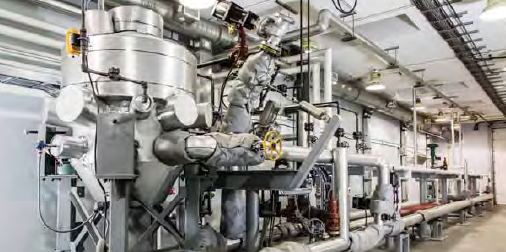Saskatoon – Finding better ways to pipeline light and heavy oil from the wellhead to process facilities will be under study at the newly expanded Pipe Flow
Technology Centre at the Saskatchewan Research Council in Saskatoon.
The Shook-Gillies High Pressure, High Temperature Test Facility opened on Jan. 7 with several oil companies already knocking on the door for applied
research projects.
The new building is equipped to test the flow conditions of volatile materials such as crude oil, in a controlled, high pressure and high temperature (HPHT)
physical model.
“We do have a few that are interested and we’ve been having discussions,” said Lesley McGilp, manager of the technology centre the day after the opening.
“The applications range from looking at fracture stimulation fluids to new instrumentation testing and looking at horizontal well flow conditions.
“I am sure as more people become aware of the system more inquiries will continue to come in. I’ve already had two or three inquiries
since the launch event yesterday.”
The facility is equipped with a 100 millimeter diameter pipe flow loop that is designed to simulate industrial conditions. The loop will be used to research the
flow of complex mixtures including slurries in pipes under HPHT conditions.
“This is a new expansion with new capabilities. With our existing loops, we can only test at low temperatures and pressures and we can’t test volatile
materials,” said McGilp.
“The new system can do all those things so we can test up to 250 Celsius and 1,300 psi in the new loop. “And we can test out volatile materials because we’ve located
the loop in a newly expanded class one building, which means it’s rated for the testing of flammable materials.”
The centre can now test a wider range of substances and help the provincial, and national, oil and gas industry enhance oil recovery, reduce operating costs
and improve processes.
“SRC is committed to benefiting Saskatchewan through its products and services and this project is no different,” said Jeremy Harrison, Minister of
Innovation and Minister Responsible for SRC in a statement.
“We expect the expansion will facilitate several research projects to improve efficiency and business productivity for oil, gas and mining companies in
our province and around the world.”
Industry will fund the projects with the research conducted by SRC following a fee for service model. Pipe flow research typically could be triggered by an operator that is having some design challenges or operational challenges.
“They would come to us with a research project, something they want to understand better,” said McGilp.
“We would run tests in our flow loop to mimic industrial conditions and that would give them information that they could use to design a pipeline or better
understand horizontal well flow or better under the properties of fracture stimulation fluids.”
The conditions that can be tested include those experienced in steam or solvent related enhanced recovery methods so SAGD technology could be
tested. “Because there is really nowhere else to test the conditions associated with steam assisted gravity drainage I do think that is a
large market for us,” said McGilp.
“There is a lot of activity in that area. I also think enhanced recovery methods in heavy oil and medium crudes is an area where we can help – that’s a technology that’s growing as oil fields mature in Canada.”
The Shook-Gillies facility can also test the pipe flow of gas and slurries that are a mixture of liquid and solids and very common in all processes of bitumen
mining in the oilsands industry.
Slurries also occur in the production of heavy oil with sand and water. “Our research would help you determine what size of pipe to use, how big your pumps might
need to be and to better understand what’s going on inside the pipe and what the flow regime looks like,” said McGilp.
“That can be important for processability when the fluid gets to a point in the operation where you want to separate the oil and the water and if there’s sand in the system to separate the sand out.
“Whether you can transport sand at the conditions that you are flowing at – we can test those things in our loop in a very controlled environment. It’s very
accurate instrumentation.”
Another benefit of pipe flow research said McGilp is that a well designed pipeline operates efficiently.
“There is less downtime, you’ve put in the right pumps so it runs more efficiently,” she noted.
“What does tend to happen in the engineering profession, when you don’t know for sure, because you don’t have good information, is you tend to err on the side of caution and build things bigger.”
“This research takes the guesswork out of the equation and allows you to design the system properly. That reduces your capital costs and will definitely improve
efficiencies.
“Particularly with slurries, building it too big is not a good thing. It will lead to operational challenges. It’s that much more important to get it right.”
The Shook-Gillies facility is named in honour of scientists Clifton Shook and Randall Gillies, two pioneers in the area of slurry testing and research at SRC’s
Pipe Flow Technology Centre that has been operating for the past 55 years. Funding for the facility included a $1.73 million joint investment from the federal and
provincial government and $1.46 million from SRC.
SRC provides services and products to its 1,400 clients in 20 countries around the world.




